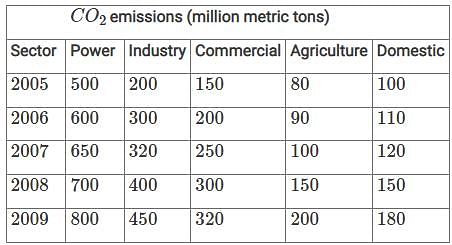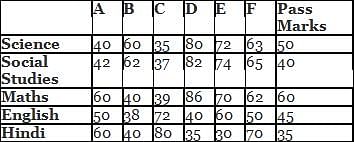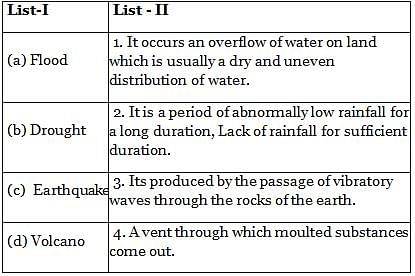UGC NET Paper 1 Practice Test - 3 - UGC NET MCQ
30 Questions MCQ Test UGC NET Mock Test Series 2024 - UGC NET Paper 1 Practice Test - 3
Under the Air Quality Index in India, which of the following pollutants is not included?
| 1 Crore+ students have signed up on EduRev. Have you? Download the App |
In the series 1, 5, 13, 25, 41, ... the next term is
"A diagram speaks more than 1000 words." - The statement means that the teacher should
Direction: Match List-I and List-II and select the correct answer from the codes given below:

The greatest cause of failure in beginning for a teacher lies in the area of
If the statement ‘None but the brave wins the race’ is false which of the following statements can be claimed to be true?
Select the correct code :
Effective teaching is by and large a function of teacher's
A new Laptop has been produced that weightless, is smaller and uses less power than previous Laptop models.
Which of the following technologies has been used to accomplish this?
Directions: Read the following passage carefully and answer the given question.
James adison said, "People who mean to be their own governors must arm themselves with power that knowledge gives." In India, the Official Secrets Act, 1923 was a convenient smokescreen to deny members of the public access to information. Public functioning has traditionally been shrouded in secrecy. But in a democracy in which people govern themselves, it is necessary to have more openness. In the maturing of our democracy, right to information is a major step forward; it enables citizens to participate fully in the decision-making process that affects their lives so profoundly. It is in this context that the address of the Prime Minister in the Lok Sabha is significant. He said, "I would only like to see that everyone, particularly our civil servants, should see the Bill in a positive spirit; not as a draconian law for paralysing Government, but as an instrument for improving Government-Citizen interface resulting in a friendly, caring and effective Government functioning for the good of our People." He further said, "This is an innovative Bill, where there will be scope to review its functioning as we gain experience. Therefore, this is a piece of legislation, whose working will be kept under constant reviews."
The Commission, in its Report, has dealt with the application of the Right to Information in Executive, Legislature and Judiciary. The Judiciary could be a pioneer in implementing the Act in letter and spirit because much of the work that the Judiciary does is open to public scrutiny. Government of India has sanctioned an e-governance project in the Judiciary for about Rs. 700 crore which would bring about systematic classification, standardisation and categorisation of records. This would help the Judiciary to fulfil its mandate under the Act. Similar capacity building would be required in all other public authorities. The transformation from non-transparency to transparency and public accountability is the responsibility of all three organs of the State.
Q. Right to Information is a major step forward to
Directions: Read the following passage carefully and answer the given question.
James adison said, "People who mean to be their own governors must arm themselves with power that knowledge gives." In India, the Official Secrets Act, 1923 was a convenient smokescreen to deny members of the public access to information. Public functioning has traditionally been shrouded in secrecy. But in a democracy in which people govern themselves, it is necessary to have more openness. In the maturing of our democracy, right to information is a major step forward; it enables citizens to participate fully in the decision-making process that affects their lives so profoundly. It is in this context that the address of the Prime Minister in the Lok Sabha is significant. He said, "I would only like to see that everyone, particularly our civil servants, should see the Bill in a positive spirit; not as a draconian law for paralysing Government, but as an instrument for improving Government-Citizen interface resulting in a friendly, caring and effective Government functioning for the good of our People." He further said, "This is an innovative Bill, where there will be scope to review its functioning as we gain experience. Therefore, this is a piece of legislation, whose working will be kept under constant reviews."
The Commission, in its Report, has dealt with the application of the Right to Information in Executive, Legislature and Judiciary. The Judiciary could be a pioneer in implementing the Act in letter and spirit because much of the work that the Judiciary does is open to public scrutiny. Government of India has sanctioned an e-governance project in the Judiciary for about Rs. 700 crore which would bring about systematic classification, standardisation and categorisation of records. This would help the Judiciary to fulfil its mandate under the Act. Similar capacity building would be required in all other public authorities. The transformation from non-transparency to transparency and public accountability is the responsibility of all three organs of the State.
Q. The Commission made the Bill effective by
Direction: Read the information carefully and answer the following question.
For a country, CO2 emission (million metric tons) from various sectors are given in the following table.

Q. What is the percentage % growth of CO2 emissions from the power sector from 2005 to 2009?
Direction: Read the information carefully and answer the following question.
For a country, CO2 emission (million metric tons) from various sectors are given in the following table.

Q. By what percentage (\%\), the total emissions of CO2 have increased from 2005 to 2009?
Direction: Read the information carefully and answer the following question.
For a country, CO2 emission (million metric tons) from various sectors are given in the following table.

Q. What is the percentage contribution of the power sector to total CO2 emissions in the year 2008?
Directions: Read the given statements carefully and choose the correct option.
Assertion (A): For an effective classroom communication, at times it is desirable to use the projection technology.
Reason (R): Using the projection technology facilitates extensive coverage of course contents.
Given below are two statements:
Statement I: Every research institute has to enforce research ethics in order to ensure the credibility and meaningfulness of human inquiry
Statement II: ICT and its use in research has abetted ethical lapses in the conduct of research wherever it has been put in place.
In the light of the above statements, choose the most appropriate answer from the options given below:
Connotative communication inside the classroom is:
Education as a subject of legislation figures in which of the following lists?
The UGC has mandated a six‐month module syllabus for UG courses for all branches of higher education with the objective:
A. to implement CBCS in the true sense
B. to enhance knowledge, skills and attitude towards the environment
C. to provide first‐hand knowledge on various local environmental aspects
D. to implement the order of Hon'ble Supreme Court of India
E. to protect the environment
Choose the correct answer from the options given below:
Directions: Answer the given question based on the following table.
Marks obtained by 6 candidates A, B, C, D, E and F:

Q. Which of the following candidates did not fail in any of the subjects?
Directions: Answer the given question based on the following table.
Marks obtained by 6 candidates A, B, C, D, E and F:

Q. The marks obtained by C in English were what percentage more than those obtained by F in Maths?
Which of the following is not the function of Mass media?
Media that exist in an interconnected series of communication - points are referred to as:
Which of the following is not related to information security on the Internet?
Match the following:

Which of the following matching is correct?
Match List - I with List - II

Choose the correct answer from the options given below:
|
16 docs|120 tests
|



























